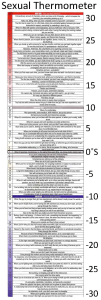Results of a 2005 IoHT Study on the Physics Hot Sex, Cold Sex, and Ambient Sex Released
Chicago, IL, July 20, 2010 --(PR.com)-- Newly published Journal of Human Thermodynamics article "Hot Sex, Cold Sex, and Ambient Sex" (19 Jul 2010), by American chemical engineer Libb Thims, presents the findings of a 2005 study of thirty individuals on the collective opinion of what constitutes hot sex verses cold sex verses ambient sex. A "sexual thermometer," quantified in units of "degrees Sex" (˚S), is derived from the study results and a discussion and critique of the concept of "sexual heat" is explained in the context of modern human chemistry, human physics, and human thermodynamics. The following 1962 comment by Austrian social economist Werner Stark, in summarizing the earlier ‘social heat’ theories of American sociologist Henry Carey, gives a good outline of the findings of the study:
“In the physical universe, heat is engendered by friction. Consequently the case must be the same in the social world. The ‘particles’ must rub together here, as they do there. The rubbing of human molecules, which produces warmth, light, and forward movement, is the interchange of goods, services, and ideas.”
The newly release IoHT study results on human sexual temperatures extend Carey’s theory of social heat of interactions, interchanges, and rubbing between the human molecules of society to the theory of ‘sexual heat’ as the heat associated with the interactions, interchanges, and rubbing together of two human molecules in the act of sex or in those states of movement, activity, and mechanism leading up to and culminating in the acts of sexual intercourse; sex being, in all reality, the dominating aspect in the mechanism of society.
###
“In the physical universe, heat is engendered by friction. Consequently the case must be the same in the social world. The ‘particles’ must rub together here, as they do there. The rubbing of human molecules, which produces warmth, light, and forward movement, is the interchange of goods, services, and ideas.”
The newly release IoHT study results on human sexual temperatures extend Carey’s theory of social heat of interactions, interchanges, and rubbing between the human molecules of society to the theory of ‘sexual heat’ as the heat associated with the interactions, interchanges, and rubbing together of two human molecules in the act of sex or in those states of movement, activity, and mechanism leading up to and culminating in the acts of sexual intercourse; sex being, in all reality, the dominating aspect in the mechanism of society.
###
Contact
Institute of Human Thermodynamics
Libb Thims
(312) 576-8158
www.humanthermodynamics.com
http://www.eoht.info/page/Libb+Thims
Libb Thims
(312) 576-8158
www.humanthermodynamics.com
http://www.eoht.info/page/Libb+Thims
Multimedia

Sexual Thermometer in Degrees Sex (˚S)
jpg of the "sexual thermometer", in units of degrees sex, from the Jul 19, 2010 JHT article by American chemical engineer Libb Thims.
Categories
